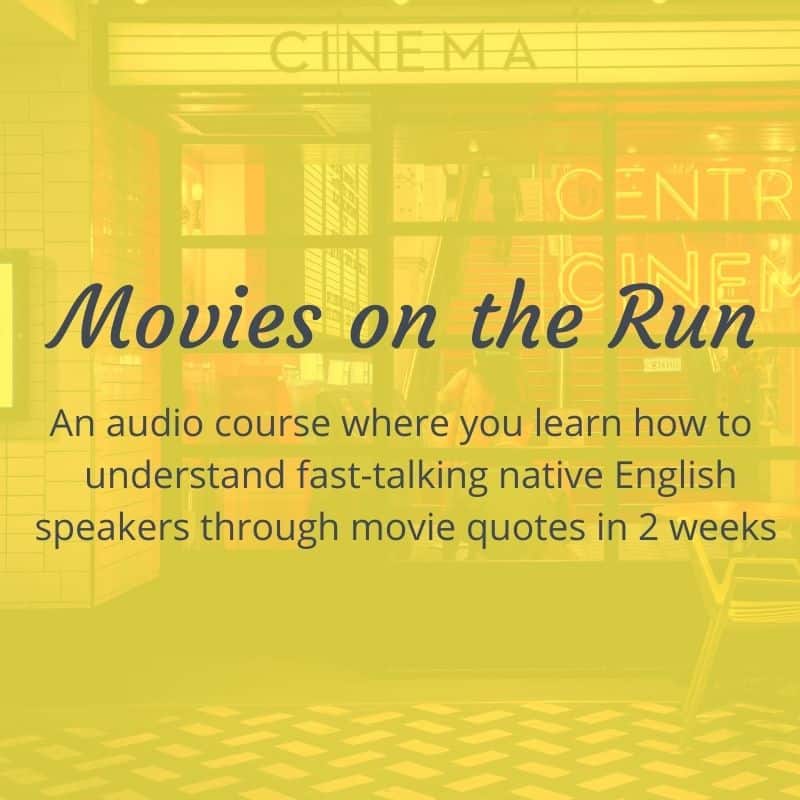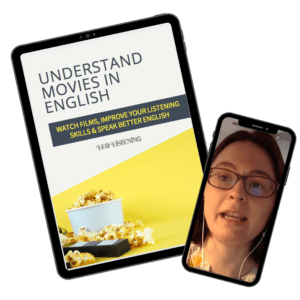I Still Need Subtitles – What’s Wrong With Me?

Updated March 2022. Listen to this article as a blogcast or continue scrolling to read it.
Back in the days when my French was starting to get good – around age 16 – I was excited to start watching films and reading books. You know, using real French material, not textbooks.
The excitement wore off pretty quickly. I came across idiomatic expressions I couldn’t figure out. And impossible to understand movie dialogue with people talking quickly and mumbling their lines.
Without subtitles, I wouldn’t have been able to watch French films. But I had a bittersweet relationship with them. I mean, on the one hand, they’re great: they help you understand. On the other hand, they’re a reminder that you’re still at an intermediate level and nowhere near fluent.
Maybe I had unrealistic expectations, but I didn’t feel good about using subtitles. And how you feel and perceive your abilities can affect your learning.
They remind you you’re inadequate in some way. One of my Leo Listeners told me she felt stupid and guilty for using subtitles after so many years of learning English. Another said subtitles make her read and not catch the spoken form of words she already knows in writing – that’s why she’s not making the progress she wants to.
That’s not to say subtitles are always negative. I asked the question below on iTalki, a language learning platform.
How do you feel when you have to use subtitles to watch films or series in English?
I got an interesting mix of responses. Some native speakers of English jumped on the discussion to tell me that they enjoy subtitles because they realise that:
- They miss parts of the dialogue without them.
- They help them focus on the dialogue: how actors deliver it and their reactions to it.
- It’s easier to catch fast sections with them because they’re good readers.
Learners of English had more negative feelings to share:
- Frustration was a word that came up a lot.
- Someone mentioned feeling insecure.
- Others mentioned not experiencing the movie in the same way because you can’t pay attention to the scenery or the actors as easily.
- Some talked about not enjoying movies as they have to concentrate more on reading.
Other learners were more positive. Some felt their abilities were good enough to switch the subtitles off. Another said that combining reading and listening could be useful.
This was my favourite answer from a learner and teacher.
“In my opinion, the best thing that can happen to a language learner is getting to the point where they don’t need subtitles anymore. After all, there are no subtitles in real life. I have friends that could get rid of subtitles if they wished to, but they don’t. Some consider watching series with English subtitles a good way to improve their skills. As I see it (as a learner and a teacher), they are being fooled by a false sense of achievement. Many times, the moments we struggle to understand something are the moments we are really acquiring language. Language acquisition is more a subconscious process than a conscious one.”
Some interesting thoughts there right? Especially the bit about struggling to understand.
Then again, there’s nothing wrong with you if you’re using subtitles – it means you’re a normal language learner and a normal person.
But as with any tool, you need to be using them in a way that serves you. If you keep using them for years in the same way and never improve your listening then you’ve got a problem.
Using spoken and written together can be powerful, but maybe not in the way you’d expect.
Read on to discover why there’s nothing wrong with you and how to use subtitles to your advantage.

Native Speakers Need Subtitles Sometimes Too
Movie dialogue can be really hard to understand. Even more so than TV series dialogue. I watched Arrival without subtitles, with my French partner not too long ago. He kept asking me what one character was saying. I had to admit that I wasn’t really sure!
It was Forrest Whittaker. I’m not sure if he speaks in such a mumbly way in all his films. But if you watch Arrival, you may need subtitles for his scenes, whether you’re a native speaker or not.
Why Do We Still Need Subtitles?
- In films and TV series, you’re the spectator. You may be listening to actors you know, but you can’t interrupt them, ask them to speak up or repeat. Your only solution is rewinding and listening again. Or turning on the subtitles if you have them. There’s nothing wrong with that.
- When you have a chat with someone in real life, your body language and facial expressions express meaning. People will know if you’re understanding or not. You can also use these nonverbal clues to understand them better. If you’re using subtitles, you might miss some visual clues. Then again, it’s easier to understand using the subtitles than trying to decipher the possible multiple interpretations of body language or scenery.
- In conversation, if you know the person well, you’re used to their voice, accent and style of speaking. When you watch films especially, you might not know the actors. You might only see them for one scene. There might not be that much dialogue
- As much as script writers try to make movie dialogue sound like real life, it doesn’t contain some of the features that can aid understanding like:
- Repetitions
- Hesitation sounds
- False starts
- Filler phrases
- Films are loooooonnnnnng. Trying to concentrate on a dialogue-heavy film like a drama for one and a half to two hours is tough, even for a native speaker. That’s why I recommend that you use shorter material like films clips rather than whole movies. You’ll find more tips like these for getting rid of subtitles in this blog post.
Reading And Listening Together Can Help
I’m not saying this is all you should ever do. Or that you should never go beyond reading and listening. But as a starting point, it’ll help.
Obviously, you need to get used to not always listening with a text. In the real world, you might see a presentation with some slides. But here we’re interested in understanding conversational English – chats between real people or dialogue on TV.
You have to start somewhere though. And a good place to do that is by combining reading and listening. That’s why I created this blogcast: so you can just listen to or read and listen to at the same time
If you learned English mainly through reading and writing, then you don’t know how words sound and you’re not sure how to pronounce them. You need to develop your awareness of how words you know sound so you can catch them when you hear them.
A non-intimidating and non-scary way to do that is to listen and read at the same time. You’ll develop your awareness of how words really sound. And of the up and down rhythm of English – the pattern of weak and strong syllables and words.
You can take this one step further by doing a shadow reading – more on that in the next section.
Even though you can simply read and listen together, I recommend that you start by listening then use the text as a way to understand your difficulties. You can find out more about how to do this in my article on using blogcasts to improve your comprehension.
When You Have A Text, You Can Start Understanding
If you have no text (no subtitles, no transcript etc) you can’t really go beyond just listening. And as you know from this blog, just listening is not enough. It’s a good start, but it’s no guarantee that you’ll actually understand. This is even true for people who are living in an English-speaking country.
Once you’ve got the text, you can start learning. I’m like a broken record with this tip, but dictations are really effective. If you don’t have the text or subtitles, you can do a dictation (write out what you heard or thought you heard), but how will you know if it’s right or not?
You’d have to ask a teacher or native speaker to confirm every single time you wanted to do one which isn’t very practical. That’s why I always write down the answers to my dictation exercises on my podcast under the audio.
When you do a course like “Movies on the Run” with me, you go one step further. You not only get the transcription of what you’ve listened too. You learn why you didn’t catch certain words.
That’s when you start having those ah-ha moments where you realise why words you already know sound so different in spoken English.
Having a text like film subtitles also means you can use the material to improve your listening and speaking. You’ve heard me talking about shadow reading. This technique gives you speaking practice and enables you to get used to the rhythm of English.
3 Reasons Why Subtitles Are A Good Thing
1. No-one understands 100%, not even native speakers. Many native speakers enjoy subtitles because they can focus more on the dialogue. Or more easily catch sections they misheard or didn’t hear at all. As we’ve seen, film dialogue can be particularly tricky to understand compared to TV series and especially to real life conversation.
2. Reading and listening together brings benefits. I’m not saying you should do this forever, but as a starting point, it can help you become aware of how words you know sound in English. Grammatical words (pronouns, prepositions, articles etc) sound particularly different, but even content words (nouns, verbs etc) can change in speech.
3. Without a text, all you can do is just listen. Not learn how to understand better. As soon as you have text such as subtitles, you have the power to transform your listening. You can do dictations, shadow readings, make wordclouds. The list goes on. You’ll find a full list of tips in my article on blogcasts or my podcast episode on how to use transcripts.
Understand Native Speakers With Movie Quotes

Fed up of watching movies with subtitles?
Feel nervous before you talk to a native speaker in case you don’t understand them?
“Movies on the Run” is an audio course that teaches you 10 English listening secrets that will help you understand native speakers when they talk fast.
Plus, you discover famous movies and the quotes that have become part of everyday speech and culture so you can fit in better. Find out more about Movies on the Run.


Dear Cara,
Thank you so much for your website! The content you provide is exactly what I’ve always needed. I can read and speak in English quite well, in fact, speaking was never a problem to me in any language. But listening and understanding an everyday speach in particular has always been a nightmare to me. This was always so stressful to have an informal talk in English, not only with native speakers. I couldn’t take advantage of so many great events in which I took part just because of my poor listening skills. I made quite a big progress over last months but there is still a lot of to do. You’re absolutely right: the biggest problem are not new words, in fact, people don’t use very rich vocabulary when they talk. The problem is that the conversational English is not that exact, sounds tend to be fuzzy. So thank you once again, I’m looking forward for you next post and podcasts!
Dear Kasia. Welcome and thank you so much for your lovely comment. I’m so glad my website is useful for you! I’m a bit like you too – I’m not scared or bothered about speaking (apart from in German where I always found it too complicated because of the grammar!) so I can understand your frustrations. If you speak well, then people assume you understand everything, even if it’s not the case. Then it becomes trickier for you to use your speaking skills – so annoying! I’m sorry to hear that your listening skills have held you back in the past – I’m sure you’ll be able to overcome that. You’re right about everyday, informal English – we probably use a core vocabulary of around 2000-3000 words in that context. And in fact, it’s often the 100 most frequent words that cause the most problems – articles, pronouns, prepositions etc. You’re right about conversational English being fuzzy too – we’re imprecise in our pronunciation and the way we use grammar. No wonder it’s difficult for people learning English!